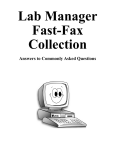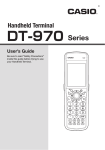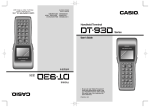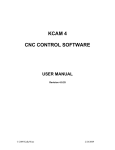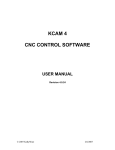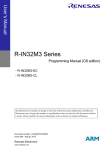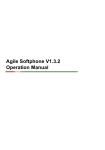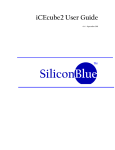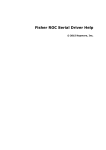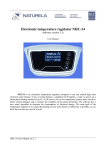Download DT-970 GUISDK
Transcript
DT-970GUISDK
First Step Guide
(Version 1.04)
CASIO Computer Co., Ltd.
Copyright ©2013-2014. All rights reserved.
September 2014
Table of the Contents
1.1.
1.2.
1.3.
Overview ························································································································································ 3
Provided Products ··································································································································· 3
Overview ························································································································································ 4
Selecting the Development Environment ·················································································· 5
2.1.
2.2.
2.3.
2.4.
Constructing the Development Environment ·········································································· 6
Windows Support of the Software Used····················································································· 6
Installation Procedure ··························································································································· 8
Precautions on Installation·············································································································· 10
Connection the DT-970 and a PC ································································································· 12
3.1.
3.2.
3.3.
Application Development and Testing ····················································································· 13
Application Development ················································································································· 13
Application Testing ······························································································································ 13
Transitioning DT-900/930/940 Applications ··········································································· 15
1.
2.
3.
No part of this document may be produced or transmitted in any form or by any means, electronic
or mechanical, for any purpose, without the express written permission of CASIO Computer Co.,
Ltd. in Tokyo Japan. Information in this document is subject to change without advance notice.
CASIO Computer Co., Ltd. makes no representations or warranties with respect to the contents or
use of this manual and specifically disclaims any express or implied warranties of merchantability
or fitness for any particular purpose.
© 2013-2014 CASIO Computer Co., Ltd. All rights reserved.
1
Editorial Record
Version
no.
1.00
1.01
October 2013
December 2013
1.02
1.03
1.04
March 2014
July 2014
September 2014
Date edited
Page
3
8
13
13
13
Content
Original version
A sample project is stored in CD folder
Explanation correction about *4, *5
Explanation correction about PATCH970.LOD
Update the version of patch files.
Update the version of patch files.
2
1. Overview
1.1. Provided Products
The DT-970 GUI SDK product CD includes the following content:
1
Included items
DT-970
Base SDK
2
DT-970
Export SDK
3
DT-970
Device Emulator
4
6
DT-970
Application Builder
DT-970
USB Driver
Manual
7
Sample applications
5
Description
An installer containing the following. A license key is required.
• RENESAS RX C compiler
• Development tools (Fontcnvw)
• DT-930 application transition tool (AppConverter)
An installer containing the following. (No license key required)
• SDK Library/ Header
• Development tools (KJ_CNVRT, APCNVY)
An installer containing the following. (No license key required)
• Emulator
• Simulator
An installer containing the following. (No license key required)
• Application Builder (IAppBuilder)
A driver for connecting DT-970 to the PC.
• Setup\USB\usbser.inf
The following manuals are included in the package.
• Hardware Manual
• Software Manual
• First Step Guide
• Application Development Guide
• Device Control Library Manual
• Support Libraries Manual
• DT-900/930/940 Application Transition Guide
• RENESAS RX Compiler Release Notes
• RENESAS User’s Manual: RX Coding
• RENESAS User’s Manual: RX Build
• RENESAS User’s Manual: Message
The same following project as DT-930 GUI SDK.
• Sample\APSMP : Display / bar code function.
• Sample\PRSMP : Printer operation
The following software, which is not included in the development environment product CD, should be
obtained separately.
• LMWIN
• Microsoft Visual Studio 2008 Professional (Microsoft Device Emulator 3.0 bundled as standard)
• Microsoft ActiveSync or Microsoft Windows Mobile Device Center
3
1.2. Overview
DT-970 applications are developed on the following Windows PCs, using the C Language.
•
•
•
•
•
•
Microsoft Windows XP Professional SP3 (x86)
Microsoft Windows Server 2003 SP2 (x86)
Microsoft Windows Vista Business SP2 (x86)
Microsoft Windows Server 2008 SP2 (x86)
Microsoft Windows Server 2008 R2 SP1 (x64)
Microsoft Windows 7 Professional SP1 (x86/x64)
The only usable functions are those that are included in the manuals “Device Control Library Manual” and
“Support Libraries Manual”, which are on the CD included in the package.
*μITRON native system calls etc. not included in the above are not supported.
DT-970 application generation uses a “RENESAS RX C compiler” that is specific to the CPU used in the
DT-970.
The created application is transferred, using LMWIN, to the DT-970.
Other than the above, it is also possible to use a Windows CE Emulator and run the Emulator for a DT-970
virtual device on a Windows PC. The Windows CE development environment is necessary for running
Emulator.
The DT-970 application development environment can coexist with the DT-930 application development
environment.
If Windows XP is used, both application development environments can be installed.
Do not install the following software in an environment in which the RENESAS RX C compiler, which is
used as the DT-970 application development environment, is installed (Coexistence on one Windows PC is
not supported).
• RENESAS CubeSuite+
• RENESAS High-performance Embedded Workshop
4
1.3. Selecting the Development Environment
There are the following three patterns of DT-970 application development, according to the usage method.
Providing Application Builder enables application development through visual and intuitive operations that
do not require expert knowledge of compilers etc.
[1] Create applications without using Application Builder, by directly using a compiler such as makefile.
[2] Create only the application for the actual device, by using Application Builder, but not using
Emulator.
[3] Use Application Builder to create the application for the actual device, and test run it using Emulator.
The software required for each pattern is as stated below.
Necessary
Software
DT-970
Base SDK
DT-970
Export SDK
DT-970
Device Emulator
DT-970
Application Builder
Casio
LMWIN
DT-970
USB driver
Windows CE
development
environment (*1)
[1]
Do not use Application
Builder or Emulator
[2]
Use Application Builder
Do not use the emulator
[3]
Use Application Builder
and Emulator
Yes
Yes
Yes
Yes
Yes
Yes
-
-
Yes
-
Yes
Yes
Yes
Yes
Yes
Yes
Yes
Yes
-
-
Yes
*1 The following software is required.
• Microsoft Visual Studio 2008 Professional (Microsoft Device Emulator 3.0 bundled as standard)
• Microsoft ActiveSync or Microsoft Windows Mobile Device Center
http://www.microsoft.com/en-us/download/details.aspx?id=8847
http://www.microsoft.com/en-us/download/details.aspx?id=14
http://www.microsoft.com/en-us/download/details.aspx?id=3182
5
2. Constructing the Development Environment
2.1. Windows Support of the Software Used
1) RENESAS RX C compiler
Supported Windows OS
Windows XP Professional (x86)
Windows Server 2003 (x86)
Windows Vista Business (x86)
Windows Server 2008 (x86)
Windows Server 2008 R2 (x64)
Windows 7 Professional (x86)
Windows 7 Professional (x64)
RX C compiler
Yes
Yes
Yes
Yes
Yes
Yes
Yes
*Also usable on Windows 8.
2) Software provided by Casio
Supported Windows OS
Windows XP Professional (x86)
Windows Server 2003 (x86)
Windows Vista Business (x86)
Windows Server 2008 (x86)
Windows Server 2008 R2 (x64)
Windows 7 Professional (x86)
Windows 7 Professional (x64)
LMWIN
Yes
Yes
Yes
Yes
Yes
Yes
Yes
DT-970 USB driver
Yes
Yes
Yes
Yes
Yes
Yes
Yes
*Supported by Windows (x86) with LMWIN Ver7. Supported by Windows 7/2008 R2(x64) with
Ver7.08.
3) Microsoft Visual Studio
Supported Windows OS
Windows XP Professional (x86)
Windows Server 2003 (x86)
Windows Vista Business (x86)
Windows Server 2008 (x86)
Windows Server 2008 R2 (x64)
Windows 7 Professional (x86)
Windows 7 Professional (x64)
Visual Studio 2008
Yes (*1)
Yes (*2)
Yes
Yes
Yes (*3)
Yes (*3)
Yes (*3)
*Visual Studio 2008 is not supported under Windows 8.
Notes:
*1...Windows XP SP2 or above
*2...Windows Server 2003 SP1 or above
*3...Visual Studio 2008 Service Pack 1 must be applied
6
4) Microsoft Device Emulator 3.0
Supported Windows OS
Windows XP Professional (x86)
Windows Server 2003 (x86)
Windows Vista Business (x86)
Windows Server 2008 (x86)
Windows Server 2008 R2 (x64)
Windows 7 Professional (x86)
Windows 7 Professional (x64)
Device Emulator 3.0
Yes
Yes
Yes
Yes
Yes
Yes
Yes
5) Microsoft ActiveSync/Microsoft Windows Mobile Device Center
Supported Windows OS
ActiveSync
Windows XP Professional (x86)
Windows Server 2003 (x86)
Windows Vista Business (x86)
Windows Server 2008 (x86)
Windows Server 2008 R2 (x64)
Windows 7 Professional (x86)
Windows 7 Professional (x64)
Yes
Yes
No
No
No
No
No
7
Windows Mobile
Device Center
No
No
Yes
Yes
Yes
Yes
Yes
2.2. Installation Procedure
Use the following procedure to install the various software on PCs used as the application development
environment.
Microsoft .NET Framework 3.5 or 3.5.1
Installation (*3)
Visual Studio 2008 Professional
Installation
(*1)
Microsoft ActiveSync or Microsoft Windows Mobile Device Center
Installation
DT-970 Base SDK (The DT-970 development environment CD is included in the
package)
DT-970 Export SDK (The DT-970 development environment CD is included in the
package)
DT-970 Device Emulator (The DT-970 development environment CD is included in the
package)
(*1)
DT-970 Application Builder (The DT-970 development environment CD is included in
the package)
(*2)
LMWIN(*4)
Installation
DT-970 USB driver (*5)
Installation
Notes:
*1 This is only required if Emulator is used.
*2 This is only required if Application Builder is used.
*3 This is not required if it is already installed on the Windows PC used.
With Windows 7 and Windows Server 2008 R2, enable Microsoft .NET Framework 3.5.1 under
activation and deactivation of Windows functions.
*4 Use Ver.7.11 or later of LMWIN.
*5 In order to install the USB driver, set DT-970 in USB communicating status, then connect DT-970 to
Windows PC via USB, and specify "usbser.inf" in a Setup\USB folder on PC.
Refer to the manual of “LMWIN” for its detail.
8
On Windows 7
The following two that are displayed under the tree tiers are not required:
• Windows Communication Foundation HTTP Activation
• Windows Communication Foundation Non-HTTP Activation
Therefore, the check box for Microsoft .NET Framework 3.5.1 is grayed out.
9
2.3. Precautions on Installation
1) Installation execution user
Installation should be performed by a user with administrator privileges.
2) Installing under Windows Vista/Windows 7/Windows Server 2008
If you are installing under Windows Vista/Windows 7/Windows Server 2008, use one of the methods
below to install in a state where UAC privilege demotion does not occur.
Method 1
Method 2
The Windows Login User should be logged in as “Administrator” to perform the
installation.
* This does not mean a user with Administrator privileges, but “Administrator” as
the actual user name.
Disable UAC.
* Control Panel -> User Accounts -> Change User Account Control.
* A reboot is required when it changes.
3) Installing without Visual Studio
The warning dialog box is displayed if the DT-970 Export SDK is installed without Visual Studio.
Please choose “Close” button and continue processing.
10
4) Installing the Device Emulator
The following dialog box is displayed if the device emulator is installed as the SDK for another model,
so uninstall the previously installed device emulator and install again.
11
2.4. Connection the DT-970 and a PC
In the DT-970 Application Development Environment, use LMWIN to transfer each type of file to the
DT-970.
Connect the PC and the DT-970 in one of the following forms:
The recommended forms of connection are 1), 2), and 3).
1) Connect directly with a USB cable [HA-N81USBC]
HA-N81USBC
MicroB-type USB connector
2) Connect with a USB cradle [HA-N60IO]
USB contact terminal
DT-380USB-A
USB cradle
[HA-N60IO]
Type B USB connector
3) Connect with a LAN cradle [HA-N62IO] via USB
The development environment does not support application transfer with LAN connection using the
LAN cradle.
USB contact terminal
DT-380USB-A
LAN cradle
[HA-N62IO]
Type B USB connector
4) Connect with an IrDA-USB cradle [HA-E60IO], and cradle attachment [HA-N64AT]
IrDA
DT-380USB
Cradle attachment
[HA-N64AT]
IrDA-USB cradle
[HA-E60IO]
Type B USB connector
12
3. Application Development and Testing
3.1. Application Development
DT-970 applications are written in C Language.
The start routine for the DT-970 application is void ap_start( ), not main( ).
Application processes are written in a form that is called from ap_start( ).
void ap_start( )
{
// TODO
}
The only usable functions are those that are included in the manuals “Device Control Library Manual” and
“Support Libraries Manual”, which are on the CD included in the package.
If these functions are used, use the header and library stated in each manual.
3.2. Application Testing
Transfer the created application via LMWIN to the DT-970, and run an operation test.
1) Patch File (PATCH001.LOD/PATCH970.LOD)
These are system files which applies functional enhancement and bug fixes.
Please transmit patch files (PATCH001.LOD/PATCH970.LOD) to DT-970.
These patch files (Ver1.20) are enclosed in this SDK.
In case the latest version is released, please get and install it.
2) Startup Application Specification File (ASTART.HTS)
If the application is put into the format (*.LOD) for transfer using LMWIN, it is necessary to specify
the program to start, but the specification is provided by this file.
The file specified here is the program that starts when “EXECUTE AP” is selected in the System
menu.
The format is that stored in the application path name.
E.g. To specify SAMPLE.LOD in the root of drive A:
A: \SAMPLE.LOD
13
3) ID File (CONFIG.ID)
When the ID file (CONFIG.ID) is created and transferred to the DT-970, it is not necessary to register
the ID manually. The file content is 6 alphanumeric characters +CR/LF.
Create the ID file as necessary and transfer it to the DT-970.
(The content of the ID file, as it stands, becomes the ID of the DT-970, so if the same file is transferred
to multiple DT-970 units, they all take the same ID).
4) System Environment File (CONFIG.HTS)
The contents of the system environment file can be reflected in “EXECUTE AP” starting or a reset
start-up by putting a system environment file on an application storing directory.
Refer to “Software Manual” for details.
Other than the above, it is also possible to use a Windows CE Emulator and run the Emulator for a DT-970
virtual device on a Windows PC.
Emulator running also allows virtual barcode input using the Simulator.
However, it is running on a virtual device, so some functions will not work.
Refer to “Application Development Guide” for details.
14
3.3. Transitioning DT-900/930/940 Applications
The DT-900/930/940 Application Transition Guide (*1) and transition tool (*2) are provided to assist in
transitioning DT-900/930/940 applications to the DT-970.
Notes:
*1 Stored in the Manuals folder of the product CD provided.
*2 Stored in the Basic Development Environment installer on the product CD provided.
The DT-900/930/940 Application Transition Guide contains the following content:
• Compatibility of functions used on the DT-900/930/940 with the DT-970
• Transitioning communications processes (Transition from Multi-drop to LMWIN. Transitioning from
IrDA to Bluetooth/LAN/USB)
Using the transition tool, it is possible to check the existence in the source of statements concerning the
above.
It is also possible to replace some content using the transition tool.
The steps of the application development procedure are basically the same as they were for the
DT-900/930/940, but the compiler and linkage editor used are different, so there are differences in aspects
such as option specifications.
On the DT-900/930/940, AP_START.OBJ and AP_INIT.OBJ were provided as startup objects for
application creation, but on the DT-970, those two objects are merged and only AP_START.OBJ is
provided. (There is no need to link to AP_INIT.OBJ)
The Memory Write Protection function that was supported on the DT-900/930/940 is not provided as a
function on the DT-970.
Therefore, the re-linkage process for reallocation of the sections below, which was run as part of the
application development procedure for the DT-900/930/940, does not need to be run on the DT-970. (In a
GUI development environment, this content is hidden, so there is no need to be concerned with it).
1. B, R section reallocation (SUBMK.EXE) after link execution with the linkage editor
2. Re-linkage execution after updating the SUBCOMMAND file
15
















